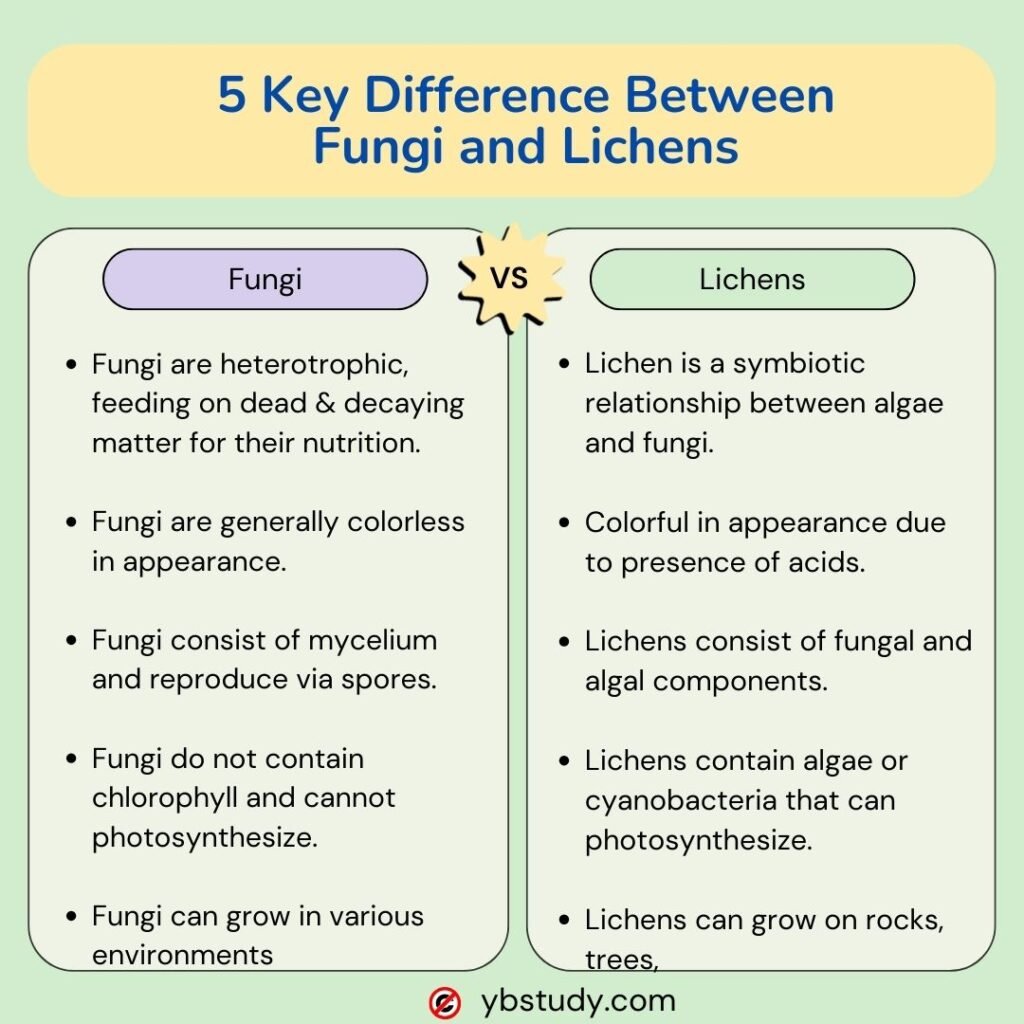5 Key Difference Between Fungi and Lichens PDF
Difference Between Fungi and Lichens: We are surrounded by many organisms, including fungi and lichens. Fungi can live independently, while lichens are made of fungi and algae living together in a symbiotic relationship. This guide will explore their definitions, structures, nutrition, growth conditions, reproduction, and importance.
What is the Difference Between Fungi and Lichens PDF
| Fungi | Lichens |
|---|---|
| Fungi are heterotrophic organisms, feeding on dead and decaying matter for their nutrition. | Lichen is a symbiotic relationship between algae and fungi. |
| Fungi are a kingdom of spore-producing organisms. | Lichens are a symbiotic association between fungi and algae or cyanobacteria. |
| Fungi are generally colorless in appearance. | Lichens are colorful in appearance due to presence of acids. |
| Fungi consist of mycelium and reproduce via spores. | Lichens consist of fungal and algal (or cyanobacterial) components. |
| Fungi can be decomposers, parasites, or mutualists. | Lichens are primarily mutualistic, benefiting both partners. |
| Fungi usually grow in shady, dark and moist places. | Lichens grow independently, exposed to air and light. |
| Fungi do not contain chlorophyll and cannot photosynthesize. | Lichens contain algae or cyanobacteria that can photosynthesize. |
| Fungi can grow in various environments, including soil and decaying matter. | Lichens can grow on rocks, trees, and harsh environments like tundras and deserts. |
5 Key Difference Between Fungi and Lichens PDF

FAQs on Difference Between Fungi and Lichens
1. What are 5 difference between algae and fungi?
Answer: Algae belong to the kingdom Protista whereas, fungi belong to the kingdom Fungi. Algae are autotrophs, and Fungi are heterotrophs. Algae contain photosynthetic pigments. Fungi are capable of digesting non-living, organic material, and also absorbs simple nutrients by the fungal hyphae. Fungi commonly grow in shady, dark and moist places. Lichens grow freely when exposed to air and light.
2. What is the color of lichen?
Answer: The most common brightly colored pigment found in the cortex of lichens is usnic acid, which gives lichens a pale yellowish-green hue. This is the classic color of beard lichens, those stringy clumps that hang from branches. Pale yellow usnic acid is best at blocking short wavelengths of ultraviolet light.
3. Are fungi multicellular or unicellular?
Answer: Except for yeast, most fungi are multicellular creatures. A fungus’ vegetative body can be unicellular or multicellular. Depending on the environment, dimorphic fungi can transition from a unicellular to a multicellular state. Yeasts are the common name for unicellular fungus.
4. What are the 5 main fungi?
Answer: Fungi contain five true phyla including Chytridiomycota, the Zygomycota, the Ascomycota, the Basidiomycota, and Glomeromycota.
